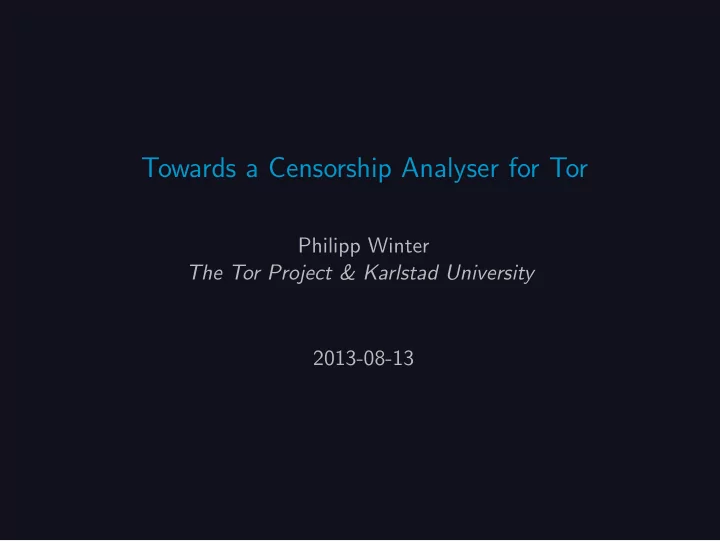

Towards a Censorship Analyser for Tor Philipp Winter The Tor Project & Karlstad University 2013-08-13
Tor and censorship ◮ Some countries, corporate firewalls, captive portals and ISPs block Tor. ◮ Blocks become known through users and dropping usage statistics. ◮ Incidents are then analysed to either modify Tor or motivate new censorship-resistant protocol (see obfsproxy et al.).
Example: pre-election censorship in Iran Number of users in Iran ● ● 50000 ● ● ● ● ● ● ● ● ● ● ● ● ● ● ● ● ● ● ● ● ● ● ● ● ● ● ● ● ● ● ● ● 20000 ● ● ● ● ● ● ● ● ● ● ● ● ● ● ● ● ● ● ● ● ● ● ● ● ● ● ● ● ● ● ● ● ● ● ● ● ● ● ● ● ● 0 Jan 01 Jan 15 Feb 01 Feb 15 Mar 01 Mar 15 Date
Motivation for this paper ◮ Analysis of censorship incidents not always straightforward. ◮ Two typical analysis scenarios ◮ Obtain shell inside censoring network and debug Tor handshake. ◮ Obtain network trace of Tor bootstrapping and study it. ◮ Problems ◮ No shells. ◮ No network traces. ◮ Dependence on technical volunteers.
Our approach to the problem ◮ How about (unskilled) users do the censorship analysis for us? ◮ Provide a small tool which automatically gathers analysis-relevant data. ◮ Comes with novel technical and ethical challenges. ◮ Important: respect user’s privacy and security.
What our analyser does
Analysis steps (1/3) ◮ Create a network trace of analysis ◮ Should be optional. ◮ Must only cover analysis. ◮ Obfuscate tests ◮ Randomise order of executed tests. ◮ Use random sleep periods between tests. ◮ Probe the website ◮ Try to download the index page. ◮ Resolve www.torproject.org and check A records. ◮ Experiment with TLS SNI and perhaps HTTP Host header.
Analysis steps (2/3) ◮ Probe the directory authorities ◮ Authorities are a popular choke point. ◮ Try to download the consensus. ◮ If it fails, ping and traceroute the authorities. ◮ Test relay reachability ◮ Connect to relay found in consensus. ◮ Step through TLS handshake. ◮ Send Tor-specific TLS client hello to unrelated machine. ◮ Test bridge reachability ◮ Bridges are relays not listed in the consensus. ◮ See if pluggable transport protocols work.
Analysis steps (3/3) ◮ Gather debug information ◮ What ISP does the user have? ◮ What is the autonomous system number? ◮ Is the user behind a captive portal? ◮ Is all traffic routed through an HTTP proxy? ◮ Anonymising reports ◮ Network traces, IP addresses, ASNs, whois and traceroutes can be discarded. ◮ However, anonymous submission is hard → Tor unavailable.
Think about the users ◮ Analyser must be as easy to use as possible. ◮ Provide user-friendly output with little jargon. ◮ Cover our analyser’s tracks and delete reports after submission. ◮ Informed consent: analyser should inform users about analysis steps and make it easy to abort process.
Create usage diversity ◮ Based on analysis results, we can recommend further steps. ◮ Therefore, our tool’s only purpose is no longer to assist in censorship circumvention. ◮ Usage diversity should make having a copy of our tool less suspicious.
Report submission ◮ We end up with a text file containing YAML-like data. ◮ Report could be submitted using email or instant messaging. ◮ Hard-coded OpenPGP public key could be used to encrypt report. ◮ Report content can be anonymised but report submission hard to do anonymously.
No need to reinvent the software wheel! ◮ OONI is a modular framework for censorship analysis and network interference (see FOCI’12 paper): https://ooni.torproject.org. ◮ We implement our analyser as several OONI tests. ◮ Finally, bundle OONI with our tests to a click-and-go executable.
class TestTorDNSEntries ( DNSTest ): a_records = [ " 38.229.72.14 ", " 38.229.72.16 ", " 86.59.30.40 ", " 93.95.227.222 " ] domains = [ "www. torproject .org", "bridges.torproject .org" ] def test_domains ( self ): def gotResult( result , domain ): self.report["a_records"] = result if set(result ). intersection (self.a_records) == set(self.a_records ): print "Host�names�resolved�as�expected." else: print "WARNING:� unexpected�resolved�host�names!" for domain in self.domains: d = self. performALookup (domain , ("8.8.8.8", 53)) d. addCallback (gotResult , domain) return d
Discussion ◮ Our analyser is not unobservable! ◮ Users with very strong threat models should not use the analyser. ◮ Additional desirable features ◮ Grammatical inference algorithm to uncover DPI fingerprints. ◮ Identify/cluster exact model of DPI hardware if possible.
Contact Email philwint@kau.se OpenPGP 2A9F 5FBF 714D 42A9 F82C 0FEB 268C D15D 2D08 1E16 Twitter @ phw Thanks to Anonymous reviewers Arturo Filast` o Simone Fischer-H¨ ubner George Kadianakis Karsten Loesing Tobias Pulls Runa Sandvik
Recommend
More recommend